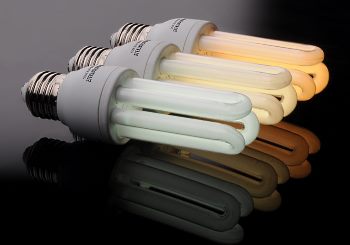property>luminous flux
What is Luminous Flux?

Luminous flux is a measure of the perceived power of light or light intensity. Because luminous flux is the measure of a property in the perceived sense, it is adjusted to deal with the fact that the human eye is sensitive to many different wavelengths of light and in different ways. Luminous flux is able to account for this sensitivity by weighting the power at each wavelength of light with a luminosity function that represents how the human eye responds to different wavelengths. In other words, because the human eye does not have a uniform response to all wavelengths of light, we have to weight our calculation of luminous flux to our understanding of how the eye responds at the different wavelengths of visible light.
To determine the total luminous flux from a given source, we do a weighted sum of the power for all wavelengths of light within the band of light that is visible to the human eye. Because luminous flux depends only on the human perception of light, all other wavelengths outside of the visible band can be neglected. The SI units for luminous flux are lumens, where a lumen is defined as a luminous intensity of one candela within a solid angle of one steradian.
Luminous flux is often used to compare the lighting power of light bulbs. It is particularly significant when comparing the effectiveness of different lighting technologies, such as comparing low-energy bulbs with the incandescent bulbs they are replacing. It is also significant when designing the lighting systems for offices, public spaces or homes.
Luminous flux is often confused, or associated with, radiant flux. It is important to emphasize that although radiant flux is a measure of the total power of light emitted, radiant flux is not adjusted to the sensitivity of the human eye through the luminosity equation, and is therefore not the same. There is, however, a concept known as luminous efficacy that is the ratio of total luminous flux to radiant flux. One might want to calculate luminous efficacy in order to determine if a light source of some kind is producing the right kind of light in the right kind of quantity for lighting up a space.
The luminosity function, as described above, will determine the luminous flux with respect to a given wavelength of light, based on evidence of how the human eye responds to different wavelengths of light. Mathematically, it is a weighted integral of the spectral power distribution of the radiation (or power per unit of wavelength). The weighting function is known as the luminosity function y(λ) which is dimensionless and where λ, is the wavelength of the light. The bounds of the integral are the upper and lower limits of the visible part of the spectrum.
There is also a difference between photopic and scotopic luminosity functions. The human eye responds to light not only based on its wavelength, but also based on its intensity. Under normal lighting conditions, the photopic luminosity function best describes the human eye’s reaction to light while the scotopic function does a better job under low light conditions. The reason for this has to do with the design of the eye that nature selected for. In low light, the retina in the eye will switch from mediating the sensitivity of light with cones to using rods instead, and this results in a shift toward the color violet (with a peak at around 507 nanometers for young eyes).